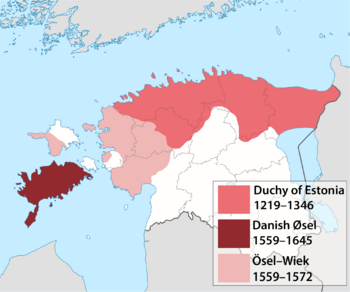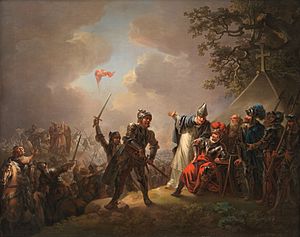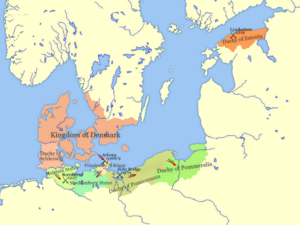Duchy of Estonia (1219–1346) facts for kids
Quick facts for kids
Duchy of Estonia
|
|||||||||||||||
|---|---|---|---|---|---|---|---|---|---|---|---|---|---|---|---|
| 1219–1346 1559–1645 |
|||||||||||||||

Territories that were part of the Kingdom of Denmark from 1219 to 1645
|
|||||||||||||||
| Status | Colony of Denmark | ||||||||||||||
| Capital | Reval (Tallinn) | ||||||||||||||
| Common languages | Danish, Estonian, Low German | ||||||||||||||
| Religion | Roman Catholicism | ||||||||||||||
| King of Denmark | |||||||||||||||
|
• 1219–1241
|
Valdemar II | ||||||||||||||
|
• 1340–1346
|
Valdemar IV | ||||||||||||||
|
• 1559–1588
|
Frederick II | ||||||||||||||
| Viceroy | |||||||||||||||
|
• 1344–1346
|
Stigot Andersson | ||||||||||||||
| Governor of Øsel | |||||||||||||||
|
• 1562–1567
|
Heinrich Wulf | ||||||||||||||
|
• 1643–1645
|
Ebbe Ulfeld | ||||||||||||||
| Historical era | Middle Ages | ||||||||||||||
|
• Established
|
1219 | ||||||||||||||
|
• Battle of Lindanise
|
15 June 1219 | ||||||||||||||
|
• Tallinn joins Hanseatic League¹
|
1248 | ||||||||||||||
|
• Disestablished
|
1346 | ||||||||||||||
|
• Danish Ösel
|
1559–1645 | ||||||||||||||
|
|||||||||||||||
| Today part of | Estonia | ||||||||||||||
|
1 Wesenberg (Rakvere) was granted Lübeck city rights in 1302 by King Erik Menved. Narva received these rights in 1345.
|
|||||||||||||||
The Duchy of Estonia, also known as Danish Estonia, was a land ruled directly by the King of Denmark. This period lasted from 1219 until 1346. After that, it was sold to the Teutonic Order, a group of German knights, and became part of their state.
Denmark became a strong military and trading power in the 1100s. They wanted to stop attacks from Estonians that were hurting their trade in the Baltic Sea. Danish ships attacked Estonia several times between 1170 and 1197. In 1206, King Valdemar II and Archbishop Andreas Sunonis raided Ösel island (Saaremaa). The Danish kings claimed Estonia, and the pope agreed. In 1219, the Danish fleet landed in Estonia's main harbor. They defeated the Estonians in the Battle of Lindanise. This brought Northern Estonia under Danish control. Danish rule lasted until the St. George's Night Uprising in 1343. After this uprising, the Teutonic Order took over the lands. Denmark officially sold these territories in 1346.
Danish Rule in Estonia

During the Livonian crusade in 1218, Pope Honorius III gave King Valdemar II permission to conquer as much land as he could in Estonia. Also, Albert of Riga, a leader of German crusaders fighting Estonians from the south, asked the king to attack from the north.
In 1219, Valdemar gathered his fleet. He joined forces with Prince Wizlav of Rügen. They landed on the northern coast of Estonia in the Lindanise (now Tallinn) harbor. This area was in the Estonian province of Revala. A famous story says that the national flag of Denmark, called Dannebrog, appeared at this time. It supposedly fell from the sky during a key moment in the Battle of Lindanise. This helped the Danes win against the Estonians. The date of the battle, June 15, is still celebrated as Valdemarsdag (Denmark's national "flag day").
The Livonian Brothers of the Sword had conquered southern Estonia. Denmark had taken the North. The two groups agreed to divide Estonia but argued about the exact borders. In 1220, the King of Denmark gave up his claim on the southern Estonian provinces of Sakala and Ugaunia. These had already been conquered by the Brothers of the Sword. Bishop Albert then gave Denmark the Estonian provinces of Harria, Vironia, and Jerwia.
In 1227, the Livonian Brothers of the Sword conquered all Danish lands in Northern Estonia. After they were defeated in the Battle of Saule, the remaining members of their order joined the Teutonic Order in 1237. On June 7, 1238, the Teutonic Order made a deal called the Treaty of Stensby with the Danish king, Valdemar II. Under this treaty, Jerwia stayed with the Teutonic Order. However, Harria and Vironia were given back to the King of Denmark. These lands became his direct possession, the Duchy of Estonia. The first Duke of Estonia was chosen by Valdemar II in 1220. This title was then used again by the kings of Denmark starting in 1269.
Life in Danish Estonia
Because it was the king's personal property, the Duchy of Estonia was listed in a Danish tax record called Liber Census Daniæ (also known as Valdemar Sejrs Jordebog). This book, from 1220–41, is an important historical document. It lists about 500 Estonian place names and the names of 114 local nobles (called vassals).
The capital of Danish Estonia was Reval (now Tallinn). It was founded where Lindanise was after the 1219 invasion. The Danes built a fortress called Castrum Danorum on Toompea Hill. Estonians still call their capital "Tallinn." A popular story says this name comes from Taani linna, meaning "Danish town or castle." Reval was given special trading rights (called Lübeck city rights) in 1248. It then joined the Hanseatic League, a powerful trading network. Even today, Danish influence can be seen in symbols. Tallinn's coat of arms has the Danish cross. The coat of arms of Estonia shows three lions, similar to the coat of arms of Denmark.
In 1240, Valdemar II created the Bishopric of Reval. A bishopric is an area led by a bishop. However, the king kept the right to choose the bishops of Reval himself. This was unusual for the Catholic Church at the time. The king's right to pick bishops was even included in the treaty when the lands were sold to the Teutonic Order in 1346.
The duchy was managed locally by a viceroy. A viceroy was a high-ranking official appointed by the king. They acted as the king's representative. The viceroy had power over administration, collected taxes, and commanded soldiers during war. Most viceroys were Danish or had Danish-Estonian backgrounds.
In Vironia, the main centers were Wesenberg (Rakvere) and Narva. These were built on the sites of older Estonian fortresses. Wesenberg received Lübeck city rights in 1302 from King Erik Menved. Narva received these rights in 1345.
The nobles (vassals) of the Danish king received land (called fiefs). In return, they provided military service and helped in the king's court. A vassal's promise to a new king lasted for "a year and a day." One historian thinks that 80% of these vassals were Germans. About 18% were likely Danes, and only 2% had Estonian names. The writer Ditleb Alnpeke complained in 1290 that the Danish king was accepting Estonians as vassals. Danish rule was more open about this than the Brothers of the Sword. In their lands, no native Estonians were allowed to become lords of fiefs. By 1248, the vassals and citizens of Reval already had their own local law-making group.

The Danish army only visited the province sometimes. From 1240–42, Denmark went to war against Novgorod. They tried to expand their rule to the land of the Votians. King Valdemar sent his sons to help his vassals, but they did not gain new territory. The Danish king Erik Plogpennig visited Estonia in 1249. The Danish fleet sailed to Reval in 1268 and 1270 to protect against threats from Novgorod and Lithuania.
End of Danish Rule
In August 1332, King Christopher II of Denmark died. Denmark then faced political problems. The province in Estonia became divided. One group supported Denmark, led by Bishop Olaf of Reval. Another group supported Germany, led by Captain Marquard Breide. After the Estonians in Harria rebelled in the St. George's Night Uprising of 1343, the Teutonic Order took over the territories. The Danish government was overthrown two days after the Order stopped the Estonian revolt. The Danish viceroy was imprisoned with help from the pro-German vassals. The castles in Reval and Wesenberg were given to the Order by the pro-German group on May 16, 1343. The castle at Narva was given in 1345.
In 1346, Estonia (Harria and Vironia) was sold to the Teutonic Order for 19,000 Cologne marks. This happened even though King Christopher II had promised in 1329 never to give up or sell Denmark's Estonian lands. The king of Denmark even publicly said he was sorry for breaking that promise and asked the Pope for forgiveness. The transfer of control from Denmark to the Teutonic Order happened on November 1, 1346.
The title of "Duke of Estonia" was used by Danish kings. It was not used during the Teutonic Order's rule. It was brought back in 1456 by Danish King Christian I. Swedish kings took the title after they gained control of Reval and northern Estonia in 1561. The title then went to the Russian emperors after they won the Great Northern War (1700–1721). It remained a side title for Russian emperors until the Romanov dynasty was overthrown in 1917.
In 1559, during the Livonian war, Frederick II of Denmark bought the Bishopric of Ösel-Wiek. This cost 30,000 thalers. This land was given to Magnus, Duke of Holstein, who was Frederick II's brother. Magnus landed on Ösel (Saaremaa) with an army in 1560. Denmark gave Wiek (Läänemaa) to the Polish-Lithuanian Union. In return, they received Livonian lands in Ösel. In 1572, Ösel was directly controlled by Denmark. In 1645, it was given from Denmark to Sweden by the Treaty of Brömsebro.
 |
See also
- First, Second and Third Swedish crusades
- History of Denmark
- History of Estonia
- History of Finland
- Northern Crusades
- Swedish Estonia
Sources





